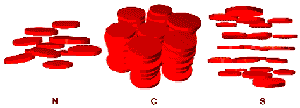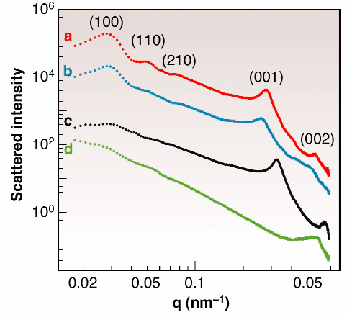- Home
- Users & Science
- Scientific Documentation
- ESRF Highlights
- ESRF Highlights 2000
- Soft Condensed Matter
- Liquid Crystal Phase Transitions in Suspensions of Plate-like Particles
Liquid Crystal Phase Transitions in Suspensions of Plate-like Particles
Colloidal suspensions that form periodic self-assembling structures on sub-micrometre scales are of potential technological interest; for instance, three-dimensional arrangements of spheres in colloidal crystals might serve as photonic materials intended to manipulate light [1]. Colloidal particles with non-spherical shapes (such as rods and plates) have "in principle" the additional ability to form liquid crystals. Nematic liquid crystals possess orientational order; smectic and columnar liquid crystals additionally exhibit positional order (in one or two dimensions respectively, see Figure 40). This columnar phase has been observed already previously in another system than the one investigated here [2]. Using small-angle X-ray scattering (SAXS) at BM26 (DUBBLE), we investigated the structure of liquid crystal phases formed in a suspension of plate-like colloids.
 |
Fig. 40: Structure of the three main classes of liquid crystals: the nematic phase (N), the columnar phase (C), and the smectic phase (S), schematically depicted here for the case of plate-like particles.
|
For hard monodisperse platelets, computer simulations predict the stability of an isotropic (I), a nematic (N), and a columnar (C) phase, respectively, upon increasing the platelet concentration [3]. We studied suspensions of sterically-stabilised gibbsite (Al(OH)3) platelets, dispersed in toluene. Like most colloidal systems, these particles are not monodisperse, i.e. the size of the particles is not strictly uniform. The relative standard deviation in the platelet diameter is 17 and 25%, respectively, for two suspensions considered. Our aim was to discover what liquid crystal phases will be formed in such polydisperse platelet suspensions.
 |
Fig. 41: Tubes containing suspensions at varying concentrations, photographed between crossed polarisers. The suspensions depicted here comprise platelets with 17% diameter-polydispersity. From left to right,
|
The phase behaviour is illustrated in Figure 41. An isotropic to nematic phase transition is observed around a volume fraction ![]() = 0.2. Moreover, around
= 0.2. Moreover, around ![]() = 0.4, a more concentrated liquid crystal phase appears. SAXS-results (Figure 42) reveal that this phase is actually a columnar phase. Upon increasing
= 0.4, a more concentrated liquid crystal phase appears. SAXS-results (Figure 42) reveal that this phase is actually a columnar phase. Upon increasing ![]() , the fraction of the columnar phase grows until a fully columnar state is reached around
, the fraction of the columnar phase grows until a fully columnar state is reached around ![]() = 0.5. Apparently, columnar ordering, as predicted for monodisperse platelets, is not inhibited by a diameter-polydispersity as high as 25%. Such a robustness against polydispersity is remarkable in the light of the so-called terminal polydispersity for the cessation of hard sphere crystallisation (around 5-10% in diameter) and the formation of a smectic phase by polydisperse rods (around 18% in rod length).
= 0.5. Apparently, columnar ordering, as predicted for monodisperse platelets, is not inhibited by a diameter-polydispersity as high as 25%. Such a robustness against polydispersity is remarkable in the light of the so-called terminal polydispersity for the cessation of hard sphere crystallisation (around 5-10% in diameter) and the formation of a smectic phase by polydisperse rods (around 18% in rod length).
 |
Fig. 42: SAXS patterns for samples varying in polydispersity
|
However, in the case of 25% diameter-polydispersity, the columnar structure breaks down rapidly upon increasing the concentration in fully columnar samples. Interestingly enough, the breakdown of the columnar structure, which is demonstrated by a suppression of the columnar (100), (110) and (210) peaks, is accompanied by the growth of the (001) and (200) peaks. One may speculate that the sudden intensification of the structure on the scale of the plate thickness, points at a crossover to smectic ordering. Unlike the columnar phase, which will be suppressed by diameter-polydispersity, a smectic phase will be suppressed by thickness-polydispersity. Hence, the experimental evidence shows that the platelets have a polydispersity in diameter as well as in thickness, this must lead to a competition in stability of a smectic and a columnar phase. This may be an explanation for the fact that platelets with a diameter-polydispersity as high as 25% are found to exhibit a columnar phase.
References
[1] A. Blanco et al., Nature, 405, 437 (2000).
[2] A.B.D. Brown et al., Eur. Phys. J. B. 11, 481 (1999).
[3] J. A. C. Veerman and D. Frenkel, Phys. Rev. A, 45, 5632 (1992).
Authors
F.M. van der Kooij, K. Kassapidou and H.N.W. Lekkerkerker, Nature, 406, 868 (2000).
Utrecht University (The Netherlands)



